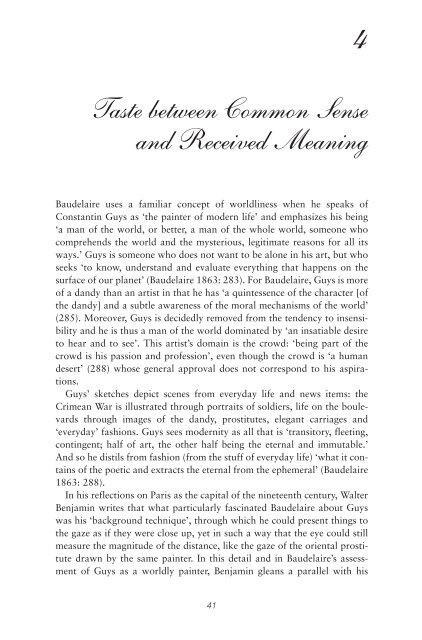You also want an ePaper? Increase the reach of your titles
YUMPU automatically turns print PDFs into web optimized ePapers that Google loves.
Taste between Common Sense<br />
and Received Meaning<br />
Baudelaire uses a familiar concept of worldliness when he speaks of<br />
Constantin Guys as ‘the painter of modern life’ and emphasizes his being<br />
‘a man of the world, or better, a man of the whole world, someone who<br />
comprehends the world and the mysterious, legitimate reasons for all its<br />
ways.’ Guys is someone who does not want to be alone in his art, but who<br />
seeks ‘to know, understand and evaluate everything that happens on the<br />
surface of our planet’ (Baudelaire 1863: 283). For Baudelaire, Guys is more<br />
of a dandy than an artist in that he has ‘a quintessence of the character [of<br />
the dandy] and a subtle awareness of the moral mechanisms of the world’<br />
(285). Moreover, Guys is decidedly removed from the tendency to insensibility<br />
and he is thus a man of the world dominated by ‘an insatiable desire<br />
to hear and to see’. This artist’s domain is the crowd: ‘being part of the<br />
crowd is his passion and profession’, even though the crowd is ‘a human<br />
desert’ (288) whose general approval does not correspond to his aspirations.<br />
Guys’ sketches depict scenes from everyday life and news items: the<br />
Crimean War is illustrated through portraits of soldiers, life on the boulevards<br />
through images of the dandy, prostitutes, elegant carriages and<br />
‘everyday’ fashions. Guys sees modernity as all that is ‘transitory, fleeting,<br />
contingent; half of art, the other half being the eternal and immutable.’<br />
And so he distils from fashion (from the stuff of everyday life) ‘what it contains<br />
of the poetic and extracts the eternal from the ephemeral’ (Baudelaire<br />
1863: 288).<br />
In his reflections on Paris as the capital of the nineteenth century, Walter<br />
Benjamin writes that what particularly fascinated Baudelaire about Guys<br />
was his ‘background technique’, through which he could present things to<br />
the gaze as if they were close up, yet in such a way that the eye could still<br />
measure the magnitude of the distance, like the gaze of the oriental prostitute<br />
drawn by the same painter. In this detail and in Baudelaire’s assessment<br />
of Guys as a worldly painter, Benjamin gleans a parallel with his<br />
41<br />
4

















